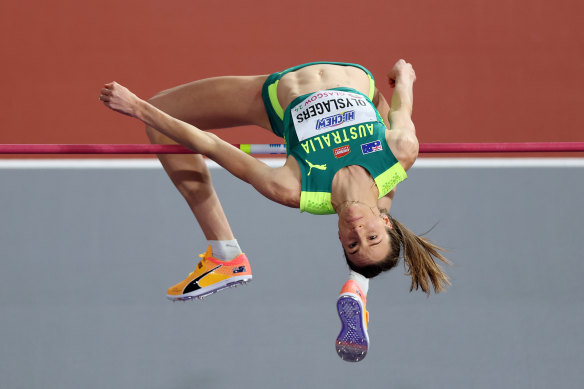A fascinating blend of physics and physiology will be on display as the world’s top female high jumpers battle gravity at the Stade de France.
These athletes aren’t just jumping over a bar. They’re using the laws of physics to push the boundaries of human jumping performance. And the task begins well before the jump itself. It starts with the run-up.

Nicola Olyslagers soars in the high jump final at the world athletics indoor championships in March.Credit: Getty Images
The main aim of the run-up is to gain kinetic energy – the energy of movement. This energy is crucial. The faster the athlete runs before the jump, the more energy they gain and, theoretically, the higher they can jump.
But there’s a catch – run too fast and the enormous forces on the jumping leg can overwhelm the nervous system, causing energy to dissipate rather than translate into vertical motion.
So, the highest jumper isn’t the one who can simply jump the highest, but rather the one who can run the fastest yet lose the least energy during the jump.
The curve of the run-up also serves a purpose, positioning the jumper’s body at the optimal angle for take-off and generating rotational energy, essential for clearing the bar later in the jump.
As the athletes transition from horizontal to vertical motion, they perform a feat that goes beyond mere jumping. They’re energy converters, transforming forward momentum into upward propulsion.
Watch closely as the jumpers drive the foot of their jumping leg into the ground. The most successful will seem to effortlessly channel their run-up energy into the jump, a skill honed through years of training. Others might show slightly more effort as energy is lost as the vibrations traverse the body at take-off.
Optimising the run-up speed is therefore critical to success. And when the nerves of competition or the desire to eke out another centimetre inevitably come, the athlete who mindfully maintains their optimum run-up speed will gain the advantage.
This moment of energy transfer is where champions are made. Those who best balance speed with control to maximise their vertical leap will win.
But the wrestle with physics doesn’t end at take-off. As jumpers sail over the bar, they perform a midair ballet that would make Isaac Newton proud.
It should nearly be impossible for a woman to jump two metres high, yet the world record stands at 2.10 metres.
To clear these heights, the jumpers have to contort their bodies in the fraction of a second it takes to clear the bar. They aim to keep as much of their mass below the bar as possible, and they push up the critical part of the body as high as possible.
During the high jump final, look at the athletes’ techniques as they pass over the bar. Their heads rock back to thrust their chests upward over the bar. A split second later their necks will flex and chests drop while their legs then flick rapidly upwards to clear the bar.
This sequence allows jumpers to jump over bars that are incredibly high, consistent with Newton’s famous law: for every action, there’s an equal and opposite reaction.
As the competition progresses and the bar goes higher, success will come to those who can consistently master this delicate interplay between physics and athleticism. With each attempt, they will need to harness their run-up energy, execute a flawless take-off and manipulate their bodies with split-second precision.
The woman to beat is Ukraine’s Yaroslava Mahuchikh, who broke the world record with a jump of 2.10 metres just a few weeks ago across town in Paris.
But two exceptional Australians will be hoping to turn scientific principles into Olympic gold – 2020 Olympic silver medallist and 2024 world indoor champion Nicola Olyslagers and 2022 world champion Eleanor Patterson.
The champion will be the athlete who best harnesses the laws of physics, jump after gravity-defying jump.
Sign up for our Sports Newsletter to get Olympic Games updates and general sport news, results and expert analysis straight to your inbox.